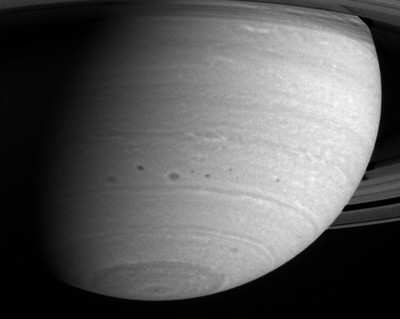Thu, Jun 04, 2009
The forecast for Titan's early autumn -- warm and wetter.
Cloud chasers studying Saturn's moon Titan say its clouds form
and move much like those on Earth, but in a much slower, more
lingering fashion.

Scientists with NASA's Cassini mission monitored Titan's atmosphere
for three-and-a-half years, between July 2004 and December 2007,
and observed more than 200 clouds. They found that the way these
clouds are distributed around Titan matches scientists' global
circulation models. The only exception is timing -- clouds are
still noticeable in the southern hemisphere while fall is
approaching.
"Titan's clouds don't move with the seasons exactly as we
expected," said Sebastien Rodriguez of the University of Paris
Diderot, in collaboration with Cassini visual and infrared mapping
spectrometer team members at the University of Nantes, France. "We
see lots of clouds during the summer in the southern hemisphere,
and this summer weather seems to last into the early fall. It looks
like Indian summer on Earth, even if the mechanisms are radically
different on Titan from those on Earth. Titan may then experience a
warmer and wetter early autumn than forecasted by the models."

On Earth, abnormally warm, dry weather periods in late autumn
occur when low-pressure systems are blocked in the winter
hemisphere. By contrast, scientists think the sluggishness of
temperature changes at the surface and low atmosphere on Titan may
be responsible for its unexpected warm and wet, hence cloudy, late
summer.
Seasons on Titan last more than seven Earth years. As Titans'
summer changes to fall at the equinox in August of this year,
Titan's clouds are expected to disappear altogether. But,
circulation models of Titan's weather and climate predict that
clouds at the southern latitudes don't wait for the equinox and
should have already faded out since 2005. However, Cassini was
still able to see clouds at these places late in 2007, and some of
them are particularly active at mid-latitudes and the equator.

Titan is the only moon in our solar system with a substantial
atmosphere, and its climate shares Earth-like characteristics.
Titan's dense, nitrogen-methane atmosphere responds much more
slowly than Earth's atmosphere, as it receives about 100 times less
sunlight because it is 10 times farther from the sun.
More News
Light Gun A handheld directional light signaling device which emits a brilliant narrow beam of white, green, or red light as selected by the tower controller. The color and type of>[...]
"The journey to this achievement started nearly a decade ago when a freshly commissioned Gentry, driven by a fascination with new technologies and a desire to contribute significan>[...]
Aero Linx: JAARS, Inc. For decades now, we’ve landed planes on narrow rivers and towering mountains. We’ve outfitted boats and vehicles to reach villages that rarely se>[...]
"Our driven and innovative team of military and civilian Airmen delivers combat power daily, ensuring our nation is ready today and tomorrow." Source: General Duke Richardson, AFMC>[...]
Aircraft Conflict Predicted conflict, within EDST of two aircraft, or between aircraft and airspace. A Red alert is used for conflicts when the predicted minimum separation is 5 na>[...]
 ANN's Daily Aero-Term (04.20.24): Light Gun
ANN's Daily Aero-Term (04.20.24): Light Gun Aero-News: Quote of the Day (04.20.24)
Aero-News: Quote of the Day (04.20.24) ANN's Daily Aero-Linx (04.21.24)
ANN's Daily Aero-Linx (04.21.24) Aero-News: Quote of the Day (04.21.24)
Aero-News: Quote of the Day (04.21.24) ANN's Daily Aero-Term (04.21.24): Aircraft Conflict
ANN's Daily Aero-Term (04.21.24): Aircraft Conflict





